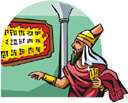Nebuchadnezzar
Also found in: Thesaurus, Encyclopedia, Wikipedia.
Nebuchadnezzar
(ˌnɛbjʊkədˈnɛzə)n
(Brewing) a wine bottle, used esp for display, holding the equivalent of twenty normal bottles (approximately 520 ounces)
[C20: named after Nebuchadnezzar2, from the custom of naming large wine bottles after Old Testament figures; compare jeroboam]
Nebuchadnezzar
(ˌnɛbjʊkədˈnɛzə) orNebuchadrezzar
n
(Bible) Old Testament a king of Babylon, 605–562 bc, who conquered and destroyed Jerusalem and exiled the Jews to Babylon (II Kings 24–25)
Collins English Dictionary – Complete and Unabridged, 12th Edition 2014 © HarperCollins Publishers 1991, 1994, 1998, 2000, 2003, 2006, 2007, 2009, 2011, 2014
Neb•u•chad•nez•zar
(ˌnɛb ə kədˈnɛz ər, ˌnɛb yʊ-)n.
1. Also, Neb`u•chad•rez′zar (-ˈrɛz ər) died 562? b.c., king of Babylonia 605?–562? B.C.: conqueror of Jerusalem. II Kings 24, 25.
2. (sometimes l.c.) a bottle for wine holding 20 quarts (18.9 liters).
Random House Kernerman Webster's College Dictionary, © 2010 K Dictionaries Ltd. Copyright 2005, 1997, 1991 by Random House, Inc. All rights reserved.
ThesaurusAntonymsRelated WordsSynonymsLegend:
Switch to new thesaurus
| Noun | 1. |  Nebuchadnezzar - (Old Testament) king of Chaldea who captured and destroyed Jerusalem and exiled the Israelites to Babylonia (630?-562 BC) Nebuchadnezzar - (Old Testament) king of Chaldea who captured and destroyed Jerusalem and exiled the Israelites to Babylonia (630?-562 BC)Old Testament - the collection of books comprising the sacred scripture of the Hebrews and recording their history as the chosen people; the first half of the Christian Bible |
| 2. | nebuchadnezzar - a very large wine bottle holding the equivalent of 20 normal bottles of wine; used especially for display wine bottle - a bottle for holding wine |
Based on WordNet 3.0, Farlex clipart collection. © 2003-2012 Princeton University, Farlex Inc.
Translations
Collins Spanish Dictionary - Complete and Unabridged 8th Edition 2005 © William Collins Sons & Co. Ltd. 1971, 1988 © HarperCollins Publishers 1992, 1993, 1996, 1997, 2000, 2003, 2005